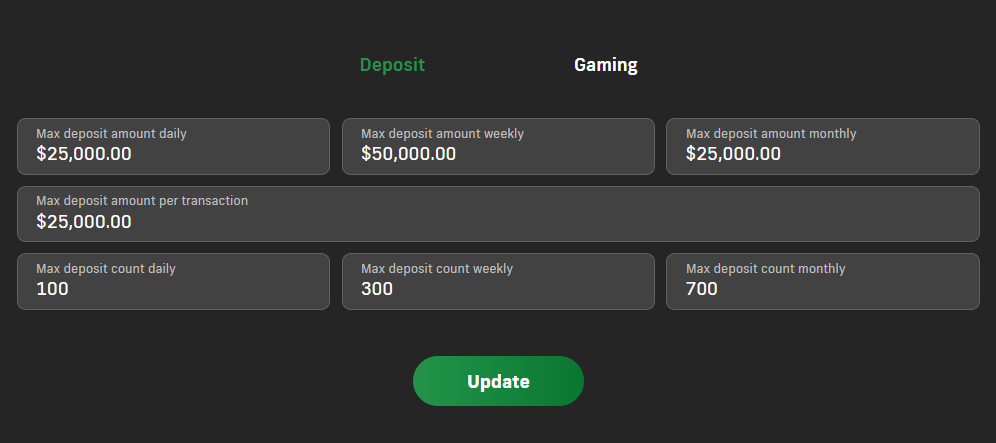Written By:
Jelena Kabić
About Author
Jelena Kabic is a sports betting writer that focusses on responsible gambling. A psychologist by vocation, Jelena volunteered in a rehab facility, where she worked with gambling addicts. She now reviews all our content to ensure it discusses betting in a socially responsible way.
Fact Checked By:
Amy Webb
About Author
Amy's introduction to the gambling world was 6 years ago, when she joined a casino operator as a content specialist. Since then, she's helped launch and maintain gambling review sites in over 8 different countries. She's tested dozens of casinos and sportsbooks, which is how she can spot a subpar brand in an instant!
Last Update
October 25, 2023
Last Update:
What is Point Spread Betting? | Point Spreads Explained
Point Spread Betting

What does +1.5 spread mean?
What is a 2.5 point spread?
How do you read point spreads?
These are just three of the many questions we get from our readers on the topic of point spread betting.
And we understand why! We also scratched our heads when we first familiarised ourselves with the concept of point spreads.
Don’t worry though, we promise that we’ll answer these questions and a lot more in this thorough guide. By the end, you will see that it’s a lot simpler than you think it is!
Best Sportsbooks Offering Point Spread Bets
What is a Point Spread Bet?
There is one crucial aspect to keep in mind for a point spread bet:
A Point Spread Bet
A point spread bet is not about who you think will win or lose, but how much they win or lose by.
In other words, the point spread is the number of points by which the team is expected to win (or lose).
Let’s look at a concrete example:
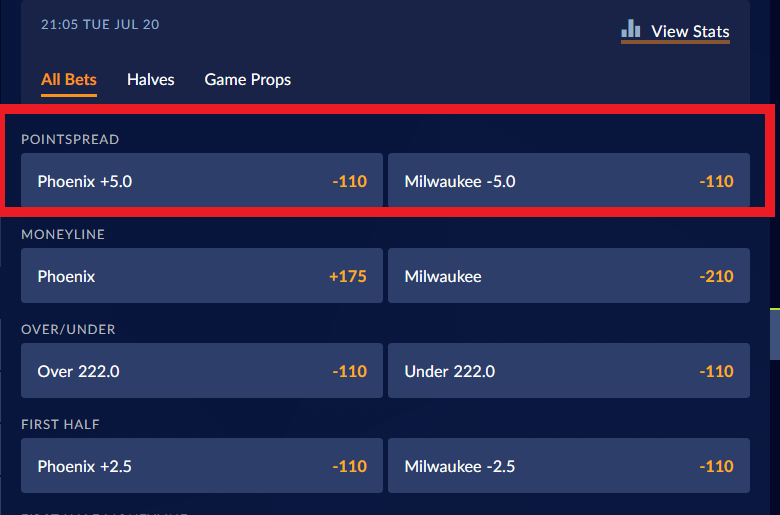
In this NBA example, Phoenix Suns are playing against the Milwaukee Bucks.
The first thing you’ll notice is that, unlike other bets, the point spread bet has a +5 and a -5 next to the two team names.
This can be confusing at first, but it’s really simple.
First of all, the + and – are an indicator of which team is the favourite, and which is the underdog.
The + sign = the underdog
The – sign = the favourite
In this case, we know that the Bucks are considered the favourite to win the game.
What about the number 5?
That number indicates the number of points the team needs to win or lose by in order for the bet to be successful.
Let’s say you bet on the Phoenix Suns.
- If the Phoenix Suns win by any number of points, you win your bet.
- If the Phoenix Suns lose the game by less than 5 points, you win your bet.
- If the Phoenix Suns lose the game by more than 5 points, you lose your bet.
If you bet on the Milwaukee Bucks:
- If the Milwaukee Bucks win the game by more than 5 points, you win the bet.
- If the Milwaukee Bucks win the game by less than 5 points, you lose the bet.
- If the Milwaukee Bucks lose the game, you lose the bet.
What happens if the Milwaukee Bucks win by exactly 5 points?
That’s a good question, and it actually happens quite often in events like the NBA and the NFL.
A Push!
A win (or loss) with the exact number of points triggers what is called a ‘push’, leading to a void bet and a refund.
To avoid this situation, a sportsbook tries to include a half number in the spread, for example, -5.5.
Keep in mind that the 5 points is specific to this example.
You can also have a point spread of 7, 2.5, 1.5 – it really depends on what point spread is required to equalize the two teams.
Point Spread Betting Odds
This brings us to our next point. You might have already noticed in our example that the odds are -110 for each team.
This can seem a bit strange to bettors used to moneyline bets. With a moneyline bet, you will always have a difference in odds between the two teams to mark the favourite and the underdog.
Top Tip!
However, the aim of point spread betting is to balance the odds of the two teams so that they both have a 50% chance of covering the spread.
So while the Bucks might have a 65% chance of winning the overall game, they have a 50% chance of covering a spread of more than 5 points and win the game.
This is why you’ll nearly always find the odds at -110 for point spread betting.
What this means is that for every $1 you win, you have to risk $1.10.
Can You Bet on Point Spreads for a Half or Quarter Game?
Definitely! The best betting sites will offer point spread options for the first half, second half, quarter, etc.
Here’s an example from Sports Interaction for a First Half Point Spread for an NBA game.

Betting options for the second half usually only open up towards the end of the first half, which requires you to do some live betting.
Why is Point Spread Betting so Popular?
Why complicate things when you can just use a moneyline bet to bet on who will win or lose, right?
Well, point spread betting has become so popular for a reason. As we’ve said before, in most sports matchups, there is a clear favourite and underdog. This makes the odds one-sided and difficult to profit from unless you spot a value bet.
On the other hand, point spread betting opens the door for many more betting opportunities.
It also gives you the chance to bet on what is likely to be the losing team, as the odds are balanced out in this type of bet.
Is it Better to Bet on the Spread or Moneyline?
This is a tricky question to answer because it depends on a lot of factors.
Top Tip!
Moneylines are easier to win, and we recommend this type of bet for beginners who are just starting out in the sports betting world.
You make a bet on which team will win the game. You either win or lose. As we mentioned before, there is generally a clear favourite and underdog, which makes it even easier to pick your bet.
The downside of a moneyline bet is that the payouts are low. Of course, you can always bet on an underdog and get a big payout, but an underdog’s win is an infrequent occurrence.
Let’s look again at the Bucks vs. Phoenix Suns.
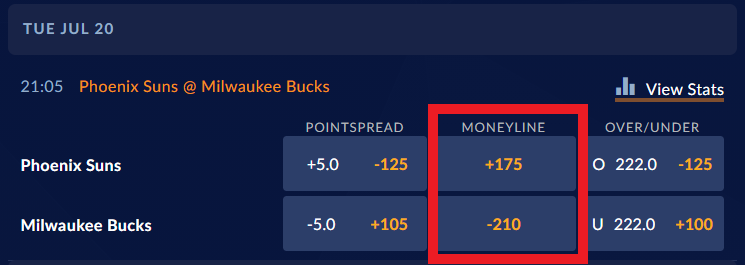
If you bet the moneyline on the favourite, odds of -210 and a $100 bet will give you winnings of just $47.62.
Of course, you can always increase winnings by wagering more money, but that should always be subject to your bankroll.
In fact, in our sports betting strategy guide, we recommend that you do not spend more than 15% of your bankroll on the same bet.
On the other hand, point spreads are harder to win because there are more variables. You’re not betting on who wins but on how far apart the final score spread will be.
The hard win comes with a reward: a better payout. If you look at the above example, the Milwaukee Bucks point spread bet has odds of +105.
Remember the $47.62 winnings from our moneyline bet? Well, now it’s a potential $105 win if we bet $100 on the Milwaukee point spread.
That’s more than double!
But to win that, the Bucks need to win by 5 points or more, which will be tight considering that in the last two previous games with the Phoenix Suns, the Bucks only won by 6 and 4 points.
Which Sports Use Point Spreads?
We’ve used an NBA example throughout this guide, but this doesn’t mean that point spreads are exclusive to the NBA.
Apart from the NBA, point spread bets are mostly used for the:
- NFL
- NCAA football
- NCAA basketball.
However, you will also see the same concept for sports like baseball and hockey, with some minor differences.
Run Line in Baseball Betting
You’ll find the term ‘run line’ being used instead of point spread betting in baseball.
Let’s take a quick look at an example:
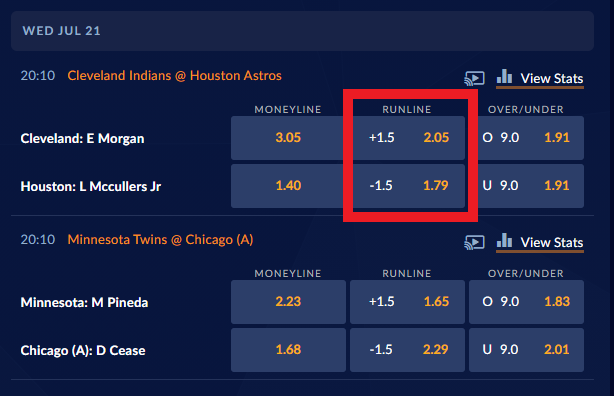
The line for baseball run lines is always 1.5, so you essentially bet on a team winning by two runs or more, or the underdog losing by one run or winning the game.
There are instances where the betting site will offer alternative lines of 2.5 runs, but the odds will be adjusted accordingly.
Puckline in Hockey Betting
The puckline in hockey betting is very similar to the baseball’s run line.
The line offered is also always 1.5, which gives the underdog an advantage of 1.5 goals and disadvantaging the favourite by 1.5 goals.
Here’s an example of what puckline odds would look like:
Toronto Maple Leafs +1.5 (+150)
Montreal Canadiens -1.5 (-185)
What About Handicap Betting?
When you bet on other sports like tennis and soccer, you will usually find a ‘handicap bet’ category.
Handicap betting is essentially the same concept as the point spread, the run line, and the puckline, and is the preferred term in Europe.
Apart from the European handicap, you might also see the term ‘Asian Handicap‘. We won’t get into detail in this guide, but the main distinction between the two is that for Asian handicaps you are not restricted to just losing or winning everything. You can also win or lose a part of the bet amount.
Conclusion
When you’re starting to bet, it’s normal to want to get away from point spread bets. At first, they are really confusing!
However, as you can see from this article, they are not that complex to understand.
To make sure you’re really comfortable with this concept and its application to sports betting, let’s summarise what we’ve discussed in this guide:
- A point spread bet gives a team an advantage or a disadvantage to provide balanced odds.
- Point spread betting is not about who wins or loses, but the number of points they will win or lose by.
- These bets are popular for basketball and football, but you will also find them for baseball, hockey, tennis, soccer and a lot more sports.
And the point spread advantage?
It brings much more flexibility for you to take advantage of the odds and create a bet that you consider to be valuable!
FAQs
What does against the spread mean?
‘Against the Spread’, also known as ATS, simply means that you’re betting on the point spread instead of another type of bet.
You can use a team’s ATS record to analyze its performance against the spread.
What is a push in point spread betting?
A push in point spread betting is when the point total hits the exact number which you bet.
Let’s say you bet on the Milwaukee Bucks as the -5 point favourite to beat the Phoenix Suns (+5). If the Bucks win by 5 points, both bets are a push and the money is refunded.
Which NFL team covers the spread?
The best way to find out which NFL teams cover the spread is to check ATS statistics.
For example in 2020, Miami Dolphins and Buffalo Bills had the most success covering the spread.
What does a negative point spread mean?
When you see a minus sign next to a team on a point spread bet it means that the team is marked as the favourite to win the game.
The number next to the minus sign means that the team is favoured by that number of points.
For example, Milwaukee Bucks -5 vs. Phoenix Suns +5 = the Bucks are the favourites to win by more than 5 points.


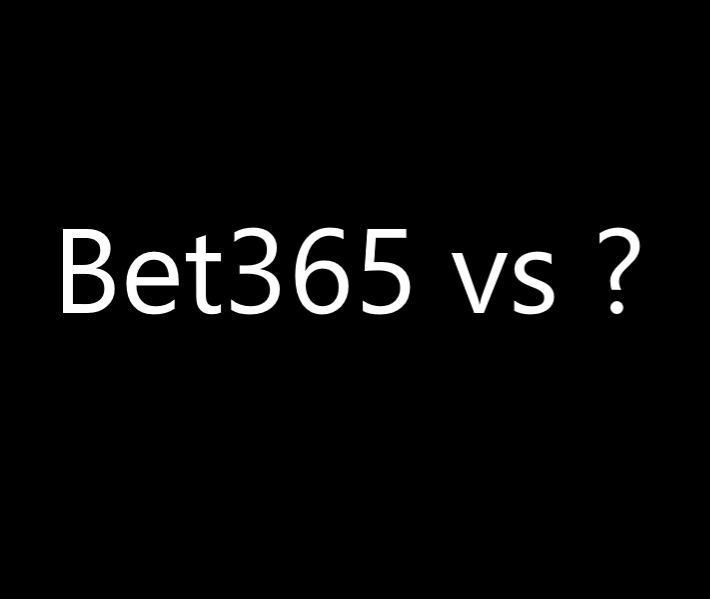


![When & How to Cash Out a Bet [Ultimate Guide]](https://legalbetcanada.com/wp-content/uploads/2023/06/cash-out.png)

